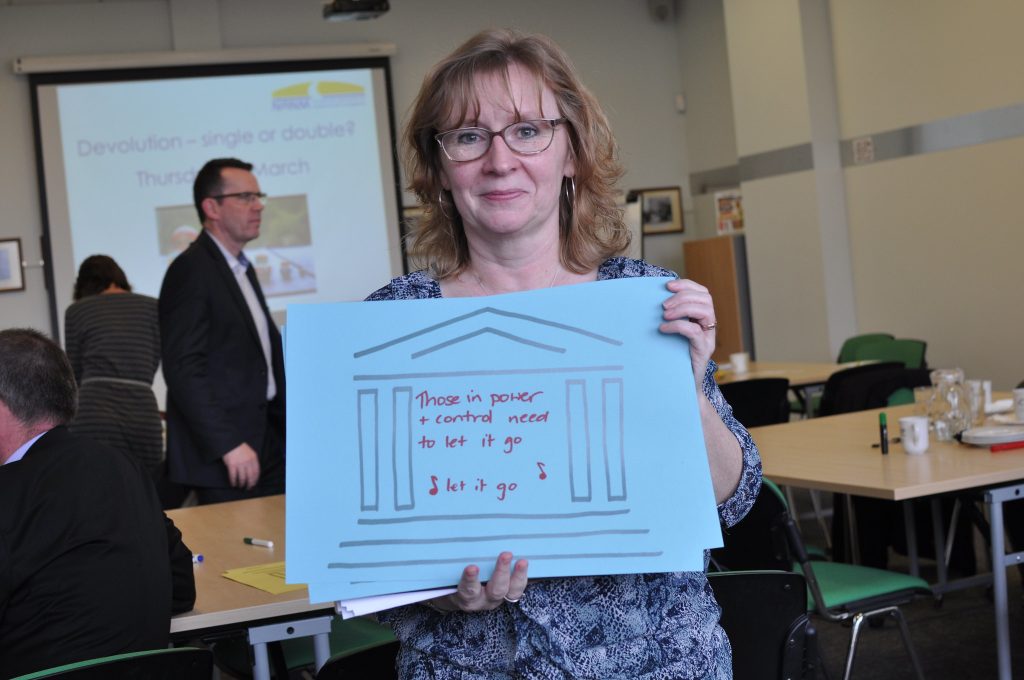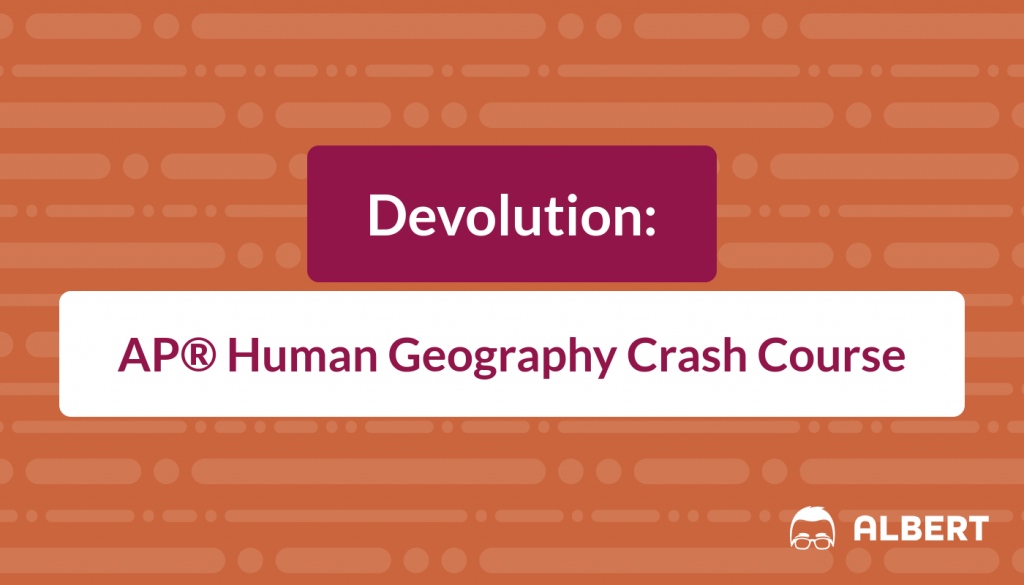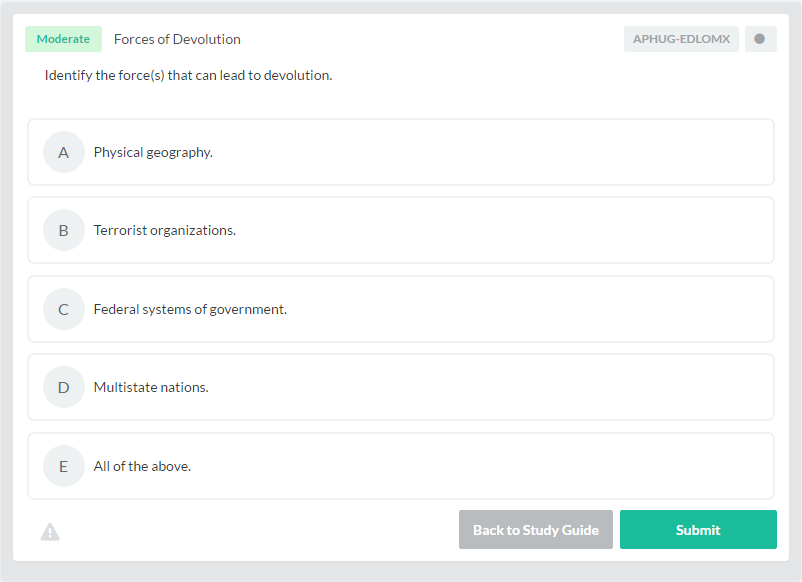There are many serious challenges facing countries today. History shows us that those challenges can and do lead to civil unrest, protest, and armed conflict. Those challenges are rooted in history and countries (also called states) must deal with the boundaries left to them by past generations. As boundaries change, the political geography of the Earth changes with it. Sometimes, these boundaries change suddenly because of armed conflict or state’s change gradually through the process of devolution.
This AP® Human Geography study guide is going to seek to describe the concept of devolution through the lens of the contemporary political-territorial world order.
Political Geography
Before we can discuss devolution, we need to understand the concepts of political geography, which involves states, territories, and boundaries, which are all interrelated and vital to the study of AP® Human Geography. More importantly to you as a citizen of planet Earth, understanding political geography helps you to make sense of the news headlines reporting conflicts and territorial disputes on a daily basis.
What Makes a State a State?
Our planet is divided into political units called countries or states. Remember, in this context; a state refers to a country and not a subdivision of the United States. Each country has defined borders, which have set boundaries. A nation is a group of unified people with a common culture. The Kurds would be an example of a nation without a state of their own. The concept of nation is important to note when we discuss forces that fragment a state. Nation-states describe a state comprised of a population with over 90 percent of a particular culture. Japan and Lesotho are good examples of nation-states.
Territories and boundaries are important ways of delineating space and have been the cause of conflict over the years. Boundaries are thin, invisible markers that can be cultural, physical, or both. Because physical boundaries are sometimes barriers to travel like mountains or water, they often are state borders. Cultural boundaries usually closely follow ethnicity and can separate two or more cultural groups.
If you look at many modern day boundaries, you will see they are geometric, drawn up by Europeans during the colonial period, with no regard to ethnic division. Disputes often arise over boundaries when countries disagree over the superimposed boundaries that split ethnic groups. This type of dispute is still evident today in the Horn of Africa. Somalia is in dispute with Ethiopia over the rights of Somalis living in the contested border between the two states.
How did the Contemporary Political Structure Evolve?
The notion of the modern state developed in Europe in the early eighteenth century. The theory that the political state was a “living organism” was used by Germany to expand and occupy its neighbors during World War II. This global expansion took the form of imperialism and colonialism. Europeans used military force, cultural domination, and formal control from the “mother country” to monitor their territories.
Imperialism and colonialism highlight how boundaries were superimposed and that countries with multi-ethnic populations are in conflict because of artificial boundaries forced on them by European powers. Eventually, the decolonization process allowed former colonies to gain their independence. Those independent countries, however, are still experiencing the after-effects of European influence and struggle with economic and political unrest.
What are Some Challenges to the World’s Contemporary System?
This discussion on states and boundaries leads us into the main topic of this AP® Human Geography study guide, devolution.
There are several challenges to the political-territorial world order dominated by national governments. These challenges raise questions about the role that national governments play in the global political system in light of organizations acting out on the world stage. Those actors can and do affect nation’s sovereignty and have been dealt with in many ways, from conciliatory to harshly. These organizations range from stateless terrorist groups to cultural minorities within the state, to other countries seeking to expand their political-territorial aims.
What are Forces that Challenge Sovereignty and Fragment a State?
Sovereignty is the internationally recognized exercise of a country’s power over its people and territory. A federal state gives local political units like states or provinces within that country a measure of power. Conversely, unitary states are characterized by a strong central government. Divisive forces threaten a country’s sovereignty by dividing the country and breaking down the central government. They are called centrifugal forces, and some examples of these forces are religious, ethno-cultural, economic, and spatial differences and can lead to devolution.
What is Devolution?

The movement of power from the central government to regional governments within the state or breakup of a large state (balkanization) into several independent ones is known as devolution. Separatism caused by centrifugal force sometimes leads to devolution as the central government ends up giving the separatist group some of its demands to keep the peace. Separatist groups include the Moros of the Philippines, the Basques of Spain, and the Sikhs in India.
The end of the Cold War saw the breakup of the former Soviet Union. That led to several challenges to ethnic autonomy and rights. Many separatist groups exist on the periphery and suffer from political and economic inequality and unequal treatment.
What Causes Devolutionary Movements?
We know that centrifugal or dividing forces cause separatism and devolution. But what are those forces at play and how do central governments deal with those forces to keep the peace in their country?
One force at play in devolutionary movements is ethno-cultural in nature. Groups that have ethno-nationalist views see themselves as distinct nations with the right to control their own territory.
The former Soviet Union is a classic example of devolution. After 50 years of communist rule, centrifugal forces in the 1980’s increased multiculturalism, multi-nationalism, and economic troubles. To appease the ethnic groups, then Soviet President Gorbachev, loosened the Soviet grip on Eastern Europe, and at home, he introduced policies of restructuring and openness. In 1989, the Iron Curtain collapsed, the Berlin Wall fell, and the devolution process was instrumental in forming the contemporary states present today in Eastern Europe. There are still growing pains in the region, but ethnic groups have much more autonomy today than they did under the former Soviet Union.
Most of the world’s 200 states have multicultural populations, so there are many examples of ethno-cultural devolution. In Spain, in 1979, Basque and Catalonia signed autonomy agreements where they have their own parliaments, their languages have official status, and they have control over education and taxation. Another ethnic minority seeking more autonomy are the Tamils in Sri Lanka. They are a Hindu minority who fight for independence from the Sinhalese, a Buddhist majority.
Spatial factors are another force at play in devolution. Countries with remote frontiers, isolated villages, rugged topography, or islands seek to be separate from their country’s central government. Examples of spatial factors causing devolution are Corsica for France, Sardinia for Italy, Taiwan for China, and East Timor for Indonesians. The United States is not immune to devolutionary forces. In 1997, native Hawaiians demanded the return of certain rights lost during the “occupation” of the island nation by the United States.
Economic forces can cause devolution as well. Poor regions of a country can feel disadvantaged by wealthier ones. Richer areas of the country can also feel put upon by having to provide subsidies to poorer ones.
A classic example of devolution is a group demanding more autonomy from the central government. That is the case of the Scots in Great Britain. Ironically the adoption of the Euro as part of the European Union (EU) created centrifugal forces in Europe. London’s decision to join the EU Scottish nationalism and during the 1990s, the Scottish National Party encouraged devolution. In 1997, the British Labour Party gave both the Scots and Welsh a chance to vote on political autonomy, and both voted to have their own parliaments.
In Italy, the richer north pushed for autonomy from the poorer south. Despite subsidies, the development gap is growing. In Brazil, wealthier provinces of the south argue that tax money is being misspent by the government for assistance to the Amazon Forest region. In the 1990’s the three southern Brazilian states of Rio Grande do Sul, Santa Catarina, and Parana elected a leader and demanded independence for the Republic of the Pampas.
Devolution and the AP® Human Geography Exam

So, what can you expect to be on the AP® Human Geography exam? Devolution is an important part of the AP® Human Geography curriculum and is part of different concepts within the area of the political organization of space. You will need to know the forces that may lead to the devolution of states including physical geography, ethnic separatism, economic, and spatial factors. For the Free Response section of the AP® Human Geography exam, we have included an example from the 2005 AP® Human Geography Exam.
Here is the AP® Human Geography FRQ from the 2005 Exam with the Scoring Guidelines.
FRQ #1
This question is concerned with the political geography concepts of supra-nationalism and devolution
1. The modern state system is engaged in a struggle between the forces of supra-nationalism and devolution.
A. Define both terms and give a geographic example for each
B. With reference to the political and economic geography of Europe, briefly discuss the changes resulting from supranationalism
C. With reference to the political and economic geography of Europe, briefly discuss three changes resulting from devolution
Scoring Guidelines
Define devolution (1 point)
Acceptable:
- Relinquishing of autonomy to internal units
- Process whereby regions within a state demand and gain political strength and growing autonomy at the expense of the central government. Breakup of a state (balkanization)
Not acceptable
- Creation of new states
Provide example (1 point)
- Breakup of a state, e.g., Yugoslavia/Balkans, former U.S.S.R., Czechoslovakia, Ethiopia/Eritrea, Austria-Hungary, British India
- Demand for greater autonomy (requires identification of internal units or groups) e.g., UK (Scotland, Wales, Ireland, Northern Ireland), Belgium, Canada (Quebec, Nunavut, native peoples), Spain (Basques, Catalonians) Italy (Padania, Tyrol), France (Corsica), U.S. (Hawaii, native peoples), India, Pakistan.
Discuss three changes resulting from devolution in Europe (3 points)
- Formation of new states/governments
- More power to regions (petitioning for /formation of new legislatures, local control over policy
- Local ethno-nationalism (linguistic/religious revival)
- Regional separatism
- Political instability (civil war, fighting, hostility, ethnic cleansing, conflict)
- Economic instability (economy declining, with supporting explanation)
- Mass migration (refugees, emigration)
Let’s put everything into practice. Try this AP® Human Geography practice question:
Looking for more AP® Human Geography practice?
Check out our other articles on AP Human Geography.
You can also find thousands of practice questions on Albert.io. Albert.io lets you customize your learning experience to target practice where you need the most help. We’ll give you challenging practice questions to help you achieve mastery in AP® Human Geography.
Start practicing here.
Are you a teacher or administrator interested in boosting AP® Human Geography student outcomes?
Learn more about our school licenses here.









